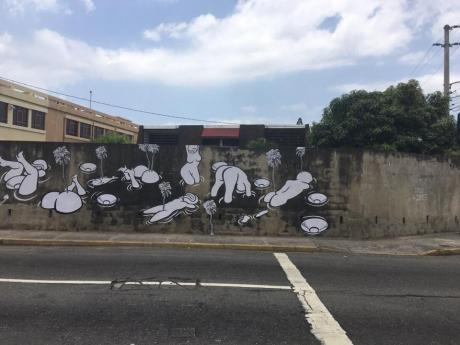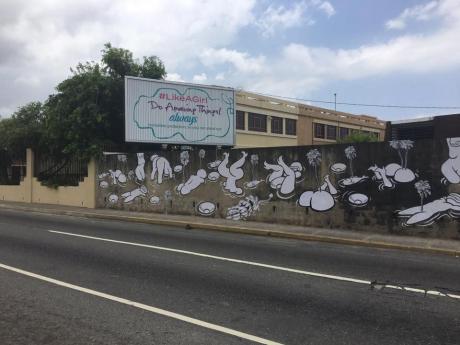Naked butts turn heads - Artist says J'cans should embrace sexiness
Naked butts turn heads
• Artist says J'cans should embrace sexiness
Many persons in the Corporate Area woke up Monday morning to a sexually laced piece of artwork, which appeared on a wall in Liguanea, St Andrew.
The piece showed a group of naked bodies in various suggestive positions in a body of water. Some of the characters had palm trees sprouting from the groin and bottom. The provocative artwork lasted less than 24 hours as it was removed, seemingly out of fear that it could corrupt public morals.
But Leasho Johnson, the creator of the piece, said it is full time Jamaicans stopped being afraid of nakedness. "I just really wanted to make young people think. It's not to scare anybody. We shouldn't be afraid of our naked body. I realise in Jamaica we have this thing where we are so afraid of the naked black body, which is kind of ridiculous," Johnson told THE STAR.
The artist, who hails from Negril, Hanover, said that the artwork was simply about exploring sexual identity and stereotypes that are influenced by Jamaica's colonial past.
"My objective is just to question why we perceive ourselves a particular way, and why the world views us the way they do. If you notice, the bodies are floating, so it's like they're behaving like an island in water. So it's a play on both what the Caribbean is, and it alludes to slavery in a way.
"The bodies almost look like those bodies that didn't make it across the Middle Passage - those that died on the ship and were thrown overboard," he explained.
stereotype
Johnson added that the trees sprouting from the groin represented the stereotype that Jamaican males are well endowed and the expectation that society has of the Jamaican male.
The artwork generated a lot of talk during the short time it was on display. Many commended Johnson, calling it "brilliant, "awesome", and "amazing." However, there were those who thought it was distasteful and inappropriate for a public space, especially because children frequently traverse the area.
When THE STAR put the latter concerns to Johnson, he said: "Child or not, you're going to encounter naked bodies at some point in life. We pass things every day that we don't really want to see, on billboard and TV. It's not like you can avoid certain things. Public art is whatever you take out of it. That's what I love about art because it usually reflects what is going on in a person's mind. If you're so comfortable, why is it making you uncomfortable?"
Children's Advocate Diahann Gordon Harrison was of the view it was "excellent" that the piece was removed because sexuality should not be normalised for children. "If it is that a piece is bordering on offensive and lewdness within the public space, then it is something that I won't encourage because it is certainly promoting a particular normalisation of sexuality," she said. "Our children are observing more than we perhaps think they are, and certain things they are exposed to in a repeated way can tend to normalise behaviour, which is not what we want."
Gordon Harrison said such artwork would be more appropriate in a space confined to the adult audience, echoing an argument that was advanced when the Redemption Song statue was unveiled at Emancipation Park more than a decade ago.








































